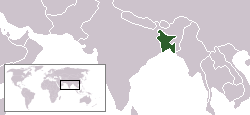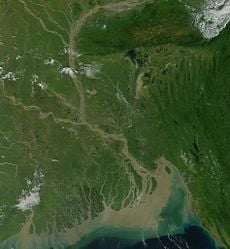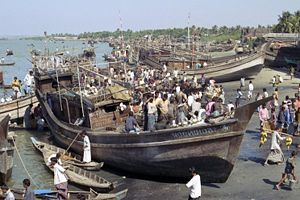Bangladesh
- Note: You may need a Bengali Font to see all the characters on this page.
| |||||

| |||||
| Official language | Bangla | ||||
| Capital | Dhaka | ||||
| President | Iajuddin Ahmed | ||||
| Prime Minister | Begum Khaleda Zia | ||||
| Area - Total - % water |
Ranked 91st 144,000 km² 7.0% | ||||
| Population - Total (July 2004 est.) - Density |
Ranked 7th 141,340,476 1,055/km² | ||||
| Independence | 1971 | ||||
| Currency | Taka (BDT) | ||||
| Time zone | Universal Time +6 | ||||
| National anthem | Amar Sonar Bangla | ||||
| Internet TLD | .bd | ||||
| Country Calling Code | 880 | ||||
The People's Republic of Bangladesh (Bangla: গণপ্রজাতন্ত্রী বাংলাদেশ, Gôno Projātontrī Bāņlādesh) is a country in South Asia that forms the eastern part of the ancient region of Bengal. Bangladesh (বাংলাদেশ) IPA: ['bɑːŋlɑːðɛʃ] literally means "The Country of Bengal". Lying north of the Bay of Bengal, on land it borders India and Myanmar, and it is a close neighbor to China, Nepal and Bhutan.
Evidence of civilization in Bangladesh dates back to 1st millenium B.C.E. After Partition of India in 1947 the area became known as East Pakistan after becoming part of Pakistan. In 1971 after years of linguistic and ethnic differences with West Pakistan, the Bangladesh Liberation War broke out. With the aid of Indian Military, the east became liberated later that year forming the nation of Bangladesh.
Bangladesh is one of the founding members of SAARC and a member of OIC. It is among the most densely populated countries in the world and much of it can be attributed to the fertile Ganges Delta and the monsoon rains that are the lifeline of Bangladesh. However, overpopulation and poverty have plagued Bangladesh, along with regular flooding. Depite being a constitutional democracy, the nation has witnessed many coups that have left the economy in a shambles.
History
There has long been advanced civilization in what is now Bangladesh, once the eastern part of a greater region called Bengal. There is recent evidence of civilizations dating back to 500 B.C.E., and there are even claims of social structures from around 1000 B.C.E. One of the earliest historical references to be found to date is the mention of a land named Gangaridai by the Greeks around 100B.C.E. The word is speculated to have come from Gangahrd (Land with the Ganges in its heart) and believed to be referring to an area in Bangladesh. However, more concrete proof of a political entity in Bengal starts with the Hindu king Shashanka in 7th century CE. This was followed (though not immediately) by the Buddist Pala dynasty and the Hindu Sena dynasty.
Bengal became Islamic starting in the 13th century and developed into a wealthy centre of trade and industry under the Mughal Empire during the 16th century. European traders had arrived in the late 15th century and eventually the British East India Company controlled the region by the late 18th century after the Battle of Plassey. Starting from this conquest, the British extended their rule over all of India. When Indian independence was achieved in 1947, political motivations caused it to be divided into the independent states of Pakistan and India.
The Partition of India saw Bengal divided between the two new countries: a Muslim-dominated eastern part called East Bengal corresponding to what is now Bangladesh, and a western part, the Indian state of West Bengal. The abolition of the Zamindari system (which divided the society into lords, owners of property, and commoners, users of property) in East Bengal (1950) was a major landmark in Bangladesh's movement to a "people's state". The Language Movement of 1952 established the rights of the Bengali community to speak in their own language, an event commomorated now as the International Mother Language Day. In 1955, the government of Pakistan changed the name of the province from East Bengal to East Pakistan.
East Pakistan was dominated and neglected by West Pakistan, which comprised the rest of Pakistan (West Punjab, Sindh, Baluchistan, and the Northwest Frontier Province). Despite the fact that East Pakistan earned the larger share of national income, especially through the export of Jute, most of the development was done in West Pakistan. The Pakistan Army was also mostly dominated by officers from West Pakistan. The tensions peaked in 1971, following an open, non-democratic denial by Pakistani president General Yahya Khan, of election results that gave the Awami League an overwhelming majority in the parliament Under the leadership of Sheikh Mujibur Rahman, also known as Bôngobondhu (Friend of Bengal), Bangladesh started its struggle for independence. The official onset followed one of the bloodiest genocides of recent times carried out by the Pakistan army on Bengali civilians on 25 March 1971. Virtually the entire Bengali intelligentsia were annihilated. Owing to West Pakistan's effort to rid the country of foreign journalists, accurate numbers are difficult to get, but some estimates claim 50,000 deaths in the first three days of the so-called Operation Searchlight of the Pakistan Army [1]. The overall death toll of the Bengalis in the nine month war is officially estimated to be around 3 million, with some Western sources citing between 1-1.5 million deaths [2]. More than ten million Bengalis fled to neighbouring India, which backed the liberation war, with support from the Soviet Union.
Sheikh Mujibur Rahman was arrested by the Pakistani Government. Before his arrest, Rahman made a formal and official declaration of Independence on 26 March. Hence 26 March is considered the Independence Day of Bangladesh. On 27 March Ziaur Rahman, an army major then, and President of Bangladesh much later, made the announcement of the declaration of Independence of Bangladesh on behalf of Sheikh Mujib, using a makeshift radio transmitter from Kalurghat near Chittagong city. With help of Bengali officers in the army, support of civilians and military/humanitarian aid from India, Bangladesh quickly formed a regular army as well as a guerilla force known as Mukti Bahini (Freedom Fighters). Besides attacks on the Pakistani army, the Mukti Bahini provided local intelligence and guidance of immense value to the allied force of Bangladesh Army and Indian Army which attacked the occupying West Pakistani army of 80,000 in early December 1971.
Within two weeks of the Indian invasion, on 16 December 1971, the Lieutenant-General A. A. K. Niazi of the Pakistan army formally surrendered to Lt.Gen. Jagjit Singh Aurora, the head of the Indian army's Eastern Command. India took 93,000 prisoners of war who were held in camps in India. Sheikh Mujibur Rahman, who had been incarcerated in West Pakistan since March, returned triumphantly as the first Prime Minister of the new nation. India withdrew its troops from Bangladesh within three months of the war.
After the war, Sheikh Mujibur Rahman became the Prime Minister and later the President of Bangladesh. He along with most of his family were massacred by a group of disgruntled Army officers on 15 August 1975. Following his death, (Major General) Khaled Mosharraf led a military coup on 3 November 1975. Khaled Mosharraf was killed in a counter coup on 7 November 1975 in the Dhaka cantonment culminating in General Ziaur Rahman gaining power and later gained the Presidency. But in 1981, he was killed in yet another coup, in Chittagong. In 1982 General Hossain Mohammad Ershad staged a bloodless coup and became the Chief Martial Law Administrator, assuming practically all power. Ershad later declared himself President and started a new political party named Janadal, which he later renamed as Jatiya Party, and ruled until 1990, when a popular uprising forced Ershad to resign and give way to a parliamentary democracy. Since then, Bangladesh has been ruled by three democratically elected governments.
Politics
Bangladesh is a Parliamentary democracy. The President is the head of state and holds a largely ceremonial post. The real power, however, is held by the Prime Minister, who is head of government. The president is elected by the legislature every five years and has normally limited powers that are substantially expanded during the tenure of a caretaker government, mainly in controlling the transition to a new government.
The prime minister is appointed by the president and must be a member of parliament (MP) who the president feels commands the confidence of the majority of other MPs. The cabinet is composed of ministers selected by the prime minister and appointed by the president.
The unicameral Bangladeshi parliament is the House of the Nation or Jatiya Sangsad, which has 300 members are elected by popular vote from single territorial constituencies for five-year terms of office. The remaining 45 seats are reserved for women, and allocated among the political parties according to their representation of elected members. There is Universal suffrage, citizens attain the right to vote at the age of 18. The highest judiciary body is the Supreme Court, of which the chief justices and other judges are appointed by the president.
Khaleda Zia is currently the Prime Minister of Bangladesh.
The politics of Bangladesh is dominated by two major parties, Bangladesh Nationalist Party and Awami League. Other major political parties include Jamaat-e-Islami Bangladesh and Jatiya Party.
In 2005 Bangladesh (along with Chad) was named by Transparency International as the most corrupt country in the world.
Geography
Bangladesh consists mostly of a low-lying river delta located on the Indian subcontinent with a largely marshy jungle coastline on the Bay of Bengal known as the Sundarbans, home to the (Royal) Bengal Tiger and one of the largest mangrove forests in the world. Bangladesh is situated in the geographic region named The Ganges Delta (also known as the Ganges-Brahmaputra River Delta). This delta is the largest in the world. Having densely vegetated lands, Bangladesh is often called the Green Delta. The densely populated delta is formed by the confluence of the Ganges (local name Padma or Pôddā), Brahmaputra (Jomunā), and Meghna rivers and their tributaries as they flow down from the Himalaya, creating the largest riverine delta in the world. Bangladesh's alluvial soil is highly fertile but vulnerable to both flood and drought. Hills rise above the plain only in the Chittagong Hill Tracts (highest point: the Keokradong at 1230 m) in the far southeast and the Sylhet division in the northeast.
Straddling the Tropic of Cancer, the Bangladeshi climate is tropical with a mild winter from October to March, a hot, humid summer from March to June, and a humid, warm rainy monsoon from June to October. Natural calamities, such as floods, tropical cyclones, tornadoes, and tidal bores affect the country almost every year, combined with the effects of deforestation, soil degradation and erosion. Dhaka is the country's capital and largest city. Other major cities include Chittagong, Rajshahi, and Khulna. Cox's Bazar, South of the city of Chittagong, has a sea beach that stretches uninterrupted over 120 km; it is frequently quoted as the World's longest natural sea beach (although this claim is difficult to prove or disprove).
Economy
Despite sustained domestic and international efforts to improve economic and demographic prospects, Bangladesh remains an underdeveloped, overpopulated, and ill-governed nation. Although more than half of the GDP is generated through the service sector, nearly two-thirds of Bangladeshis are employed in the agriculture sector, with rice as the single most important product.
Among other crops, Jute has been the major foreign exchange earnings cash crop from Bangladesh. Almost 70% of the export earnings of Bangladesh came from Jute immediately after the independence. Jute is the second Natural Fiber widely cultivated in the world after cotton. And Bangladesh is the major producer of Jute in the world.
However, major portion of the export earnings of Bangladesh comes from the Garments Industry. During the 80s, the garments sector in Bangladesh boomed very rapidly. This was possible because of the very low cost labor, which attracted the foreign investors to invest in the garments sector. The garments sector has developed a comprehensive network of businesses in Bangladesh, from yarn, lables, accessories, and fabrics, to ready made garments. The garments industry employs almost 40% of the female population in Bangladesh.
Major impediments to growth include frequent cyclones and floods, inefficient state-owned enterprises, mismanaged port facilities, a rapidly growing labour force that has not been absorbed by agriculture, inefficient use of energy resources (such as natural gas), insufficient power supplies, and slow implementation of economic reforms, caused by political infighting and corruption. In 2001, 2002, and 2003, Transparency International's surveys ranked Bangladesh as the World's most corrupt country.
Since June 2004 Bangladesh has been ravaged by its worst floods in six years, which have killed 628 people so far and covered about 60% of the country. About 20 million people are in need of food aid on account of damaged crops, and the textile industry which earns 80% of the country's export earnings has been disrupted. Officials estimate that the damage incurred could approach US$7 billion (Yahoo!News).
The July 19, 2005 issue of the New York Times reported that an eight story shopping mall (the largest in South Asia) has recently opened in Dhaka, the capital of Bangladesh. The large influx of shoppers belies the notion that the economy of Bangladesh has been stagnant, and also reveals the growth of the middle class in the country. Observers credited an expansion in the textile and garment trade for bringing some prosperity to the country.
Demographics
Apart from very small countries or urban city-states such as Singapore and Bahrain, Bangladesh is the most densely populated country in the world. The nation, at 982 persons per km², has often been compared to Indonesia's Java.
Bangladesh is ethnically homogenous, with Bengalis comprising 98% of the population, the rest belonging to the tribal people. The vast majority speak Bangla, or Bengali, an Indo-Aryan language written in the Bengali script. It is the official language, though English is accepted in official tasks and in university-level education. A small number of people, mostly non-Bengali Muslims from regions of India such as Bihar speak Urdu. A substantial number of non-Bengali tribal groups inhabit the Chittagong Hill Tracts in the southeast and the Northern regions Bangladesh, including parts of the districts of Mymensingh, Sylhet, Rangpur. Almost all non-Bengali Bangladeshis speak Bangla as a second language.
Most Bangladeshis (about 83%) are Muslims, but Hindus constitute a sizable (16%) minority. There are also a small number of Buddhists, Christians, and Animists.
Bangladesh has a high population growth rate. In the mid-eighties, the government began promoting birth control to slow population growth, but with limited success. However, the Government has gained considerable success in preventing the spread of many childhood diseases, through an effective nationwide immunisation policy.
Many are landless or forced to inhabit hazardous floodplains, with the consequence of rampant water-borne disease. In an effort to stem the spread of pathogens like cholera and dysentery, international organizations began to promote well-drilling throughout the nation. Several years after widespread implementation of the programme, over a quarter of the population exhibited symptoms of arsenic poisoning. High levels of naturally occurring arsenic in the water table of certain regions has not been accounted for. The effects of arsenic-tainted water still remain a problem.
Culture
Sports
Although Bangladesh is not a major sporting power in any sense, Bangladeshi athletes and sportspersons have brought the country many laurels. Kabadi (কাবাডি) is the national game of Bangladesh, though recently cricket has gained popularity in the urban areas. In the international arena, cricket and chess have brought many victories to Bangladesh. In 2005, Bangladesh beat the world champions Australia in a one-day match in England, and Niaz Morshed became the first Grandmaster of the subcontinent. Bangladeshi Shooters have also won medals in Commmonwealth games and Asian Games.
Education
Education in Bangladesh is highly subsidized by the Government, which operates many schools and colleges in the primary, secondary and higher secondary level as well as many public universities. The whole country is divided into seven education boards (Dhaka, Chittagong, Rajshahi, Jessore, Barishal, Sylhet and Comilla Education Boards) which oversee education from the primary to the higher secondary level, and conduct the primary and junior scholarship examinations, the Secondary School Certificate examination, and the Higher Secondary Certificate examination. The Government also provides a large portion of the salaries of the teachers in non-government schools. To promote literacy among women, education is free upto the higher secondary level for female students. There is also a Government-funded program which gives incentives like stipends and food for continuing education in the secondary level.
There are 22 Public Universities in Bangladesh. Among them five provide engineering education and the rest are general universities.
Further reading/Non-government sites
- Bangladesh Gateway
- Banglapedia - National Encyclopedia of Bangladesh
- Bangladesh Garment Manufacturers and Exporters Association
- Federation of Bangladesh Chambers of Commerce and Industry
- Bangladesh Statistical Information and Resources
Government and government organizations
- Bangladesh Customs Home Page (National Board of Revenue)
- Bangladesh Government Official Web Page
- Bangladesh Telephone and Telegraph Board (BTTB/T&T)
- Dhaka City Corporation
- Election Commission Secretariat
- Legislative Information Centre - Official parliamentary site
Newspapers
| Bangla newspapers | English newspapers |
Online Bangladeshi news sources
Credits
New World Encyclopedia writers and editors rewrote and completed the Wikipedia article in accordance with New World Encyclopedia standards. This article abides by terms of the Creative Commons CC-by-sa 3.0 License (CC-by-sa), which may be used and disseminated with proper attribution. Credit is due under the terms of this license that can reference both the New World Encyclopedia contributors and the selfless volunteer contributors of the Wikimedia Foundation. To cite this article click here for a list of acceptable citing formats.The history of earlier contributions by wikipedians is accessible to researchers here:
The history of this article since it was imported to New World Encyclopedia:
Note: Some restrictions may apply to use of individual images which are separately licensed.


